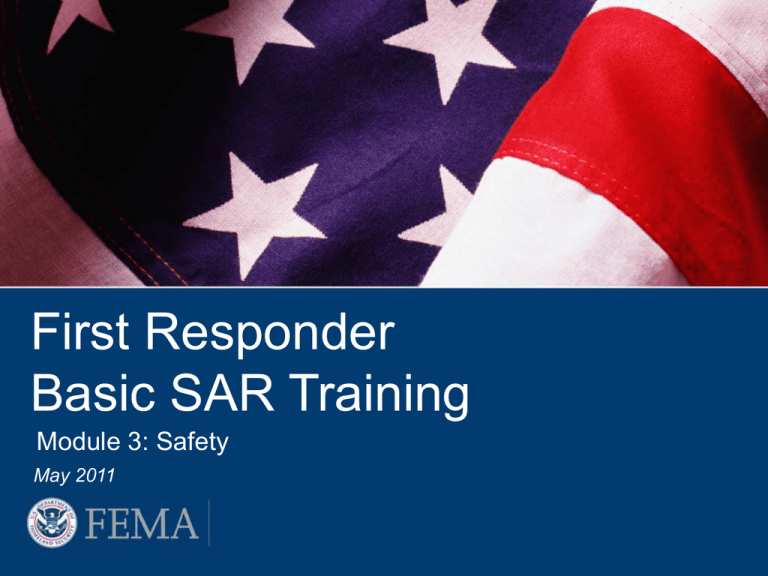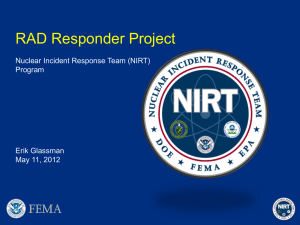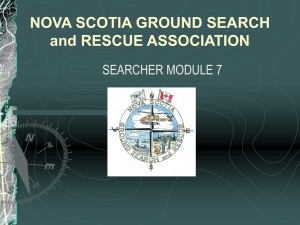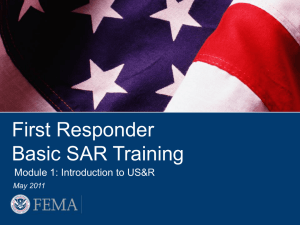Enabling Objectives
advertisement

First Responder Basic SAR Training Module 3: Safety May 2011 First Responder Basic SAR Training Module Objective Upon completion of this module, participants will understand and recognize hazards associated with disaster operations and methods of hazard mitigation. 1 First Responder Basic SAR Training Enabling Objectives Successful participants will; • Recognize hazards associated with operating at or near a disaster site • Understand hazard mitigation strategies and appropriate personal protective equipment 2 First Responder Basic SAR Training Unit 1 Hazards 3 First Responder Basic SAR Training Terminal Objective Upon completion of this unit, participants will be able to understand and recognize the hazards associated with operating at or near a disaster site. 4 First Responder Basic SAR Training Enabling Objectives Successful participants will: • Recognize the physical hazards of the disaster site • Understand the chemical / atmospheric hazards present 5 First Responder Basic SAR Training Damaged Infrastructure • Transportation corridors – Compromised traffic signals • Utilities – Electrical hazards – Waste water release – Gas leaks • Levees or dams – Rapid flooding 6 First Responder Basic SAR Training Engulfment / Entrapment • Engulfment – Open pit – Septic system – Underground storage tank • Entrapment – Additional collapse 7 First Responder Basic SAR Training Slip / Trip / Fall • Uneven and wet surfaces increase the risk • May be working at elevations, fall could be fatal • Sharp objects in scattered debris 8 First Responder Basic SAR Training Energy Release • Unexpected release of electricity • Unexpected start up of machinery • Restoration of power grid without notifying responders • Release of steam, hydraulic fluid, or gas 9 First Responder Basic SAR Training Temperature Extremes • Temperature and humidity extremes hazardous to responders and survivors • High temperature/high humidity – Heat stress and heat cramps – Heat exhaustion – Heat stroke 10 First Responder Basic SAR Training Other Hazards • • • • • High noise Low light Loose and displaced animals Poisonous spiders and snakes Animal predators 11 First Responder Basic SAR Training Chemical Contamination • Inhalation • Ingestion – Lack of personal hygiene • Injection • Absorption – Direct contact with liquid or gas – Contact with sweat then absorbed through skin 12 First Responder Basic SAR Training Asphyxiating Atmospheres • Interfere with body’s ability to absorb enough oxygen to sustain life • May displace oxygen in confined space • May interfere with body’s ability to utilize available oxygen – Carbon monoxide – Hydrogen sulfide • If suspect leave area, contact HazMat 13 First Responder Basic SAR Training Flammable Atmosphere • Chemicals in industry and home • May not be able to smell flammable liquids • Heavier than air, may be concentrated around your feet • Should suspect presence when entering partial collapse 14 First Responder Basic SAR Training Toxic Atmosphere • Chemicals in industry and home • May not be toxic until containers broken during disaster and contents mixed • If in doubt, have HazMat identify potential hazards before entering area 15 First Responder Basic SAR Training Summary Understanding hazards and looking for and recognizing them allows disaster responders to avoid hazards and protect themselves from the effects of the hazards. 16 First Responder Basic SAR Training Unit 2 Hazard Mitigation / PPE 17 First Responder Basic SAR Training Terminal Objective Upon completion of this unit, participants will be able to understand various hazard mitigation strategies and the appropriate personal protective equipment needed for operating at or near a disaster site. 18 First Responder Basic SAR Training Enabling Objectives Successful participants will understand hazard mitigation strategies and the use and limitations of personal protective equipment including: • Avoidance measures to reduce the risk of exposure and injury • Engineering controls as a hazard mitigation strategy to ensure safe operation • Personal protective equipment necessary to protect from the existing and predictable hazards of disaster operation 19 First Responder Basic SAR Training Hazard Avoidance Strategies • Awareness and recognition of the risk • Maintain safe operating distance from hazard • Mark hazard to alert other responders 20 First Responder Basic SAR Training Engineering Control • Disconnecting electricity, turning off machinery, shutting of gas valve – Tagged to alert others • Shoring and building stabilization • Positive or negative pressure ventilation • Remove hazard – Minimize trip hazards 21 First Responder Basic SAR Training Personal Protective Equipment • Last line of defense • Equipment – Gloves – Proper footwear – Eye protection – Helmets – Hearing protection 22 First Responder Basic SAR Training Respiratory Protection • Approved respirators necessary at times • N95 particulate air respirator – often sufficient against most dust particles in air – Must be replaced regularly – Does not filter out toxic vapors • Air purifying respirators necessary in toxic atmospheres 23 First Responder Basic SAR Training Skin Contact Protection • Long-sleeved, durable outer wear – Protects against cuts, scratches • Military Mission Oriented Protective Posture (MOPP) – Based on known or suspected hazards – Defines the level of protective garments worn – Higher the number, greater the level of protection • Causes more physiologic stress to the body – Risk of wearing chemical protective clothing may be greater than the chemical hazard risk 24 First Responder Basic SAR Training 25 First Responder Basic SAR Training Summary • SAR responders must be capable of recognizing existing and predictable hazards in the area • PPE must be worn if avoidance and engineering controls are not adequate • Respiratory protection may be needed based on the respiratory hazards • Appropriate protective equipment must be worn if contaminants can be absorbed or can penetrate the skin 26







